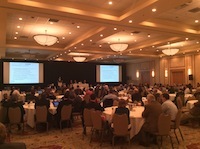
WPAC enjoys sold-out event
December 2, 2014
By
Amie Silverwood
 Dec. 2, 2014 – This year’s WPAC conference was completely sold out with 300 attendees and as many exhibitors as the organizers could fit. In fact, even the pre-conference tours and workshops exceeded capacities with private cars added to carry the overflow to Fibreco.
Dec. 2, 2014 – This year’s WPAC conference was completely sold out with 300 attendees and as many exhibitors as the organizers could fit. In fact, even the pre-conference tours and workshops exceeded capacities with private cars added to carry the overflow to Fibreco.
 Dec. 2, 2014 – This year’s WPAC conference was completely sold out with 300 attendees and as many exhibitors as the organizers could fit. In fact, even the pre-conference tours and workshops exceeded capacities with private cars added to carry the overflow to Fibreco. Over 30 exhibitors packed the venue and over 40 speakers meant that more than 400 industry professionals were represented at the conference.
Dec. 2, 2014 – This year’s WPAC conference was completely sold out with 300 attendees and as many exhibitors as the organizers could fit. In fact, even the pre-conference tours and workshops exceeded capacities with private cars added to carry the overflow to Fibreco. Over 30 exhibitors packed the venue and over 40 speakers meant that more than 400 industry professionals were represented at the conference.
President of WPAC, Brad Bennett (also the Vice President of Pacfic Bioenergy) was re-elected for another two years at the annual AGM. Bennett welcomed attendees with a note on sustainability of fibre – a controvercial topic that the industry must tackle to stay ahead of European policies that scrutinize fibre sources.
The good news from his perspective is that most Canadian pellet producers don’t have a lot of work to do to demonstrate wood fibre sustainability. He recommended hiring a local certification expert to help make any necessary tweaks.
“We can create a brand for our product that we sell worldwide,” explained Bennet with regards to the Sustainable Biomass Partnership certification in the works. “It will be a worldwide system that will create a momentum with regulatory bodies.”
“We can create a brand for our product that we sell worldwide,” explained Bennet with regards to the Sustainable Biomass Partnership certification in the works. “It will be a worldwide system that will create a momentum with regulatory bodies.”
There was plenty of good news at the conference indicating the industry will continue to grow over the short and long term. Europe is the major destination for Canadian pellets but markets are emerging in Japan and South Korea.
As the industry continues to grow, so do pellet producers’ concerns about accessiblity of fibre and fibre security. Rob McCurdy from Pinnacle Pellet showed attendees some shocking photos of forestry residuals going up in smoke. He accused forestry companies of burning the tops and limbs rather than selling them to the local pellet mill.
“The current system is not working,” said McCurdy, “fibre is still going up in smoke.”
COFI Director, Ken Shields (also CEO of Conifex) pointed to the reduced fibre supply and timber supply in B.C. as a result of the mountain pine beetle that swept through the region ten years ago. “It’s the first decade in B.C. where we’ll face a structural decline in the forest,” he said. “Our two industry associations should be united in a common struggle to ensure fibre costs are competitive with those in other supply regions.”
According to Shields, it’s not a simple task to determine how economically feasible it is to access the biomass in the forest. But the best way forward is to defend a robust primary manufacturing sector with a diverse product mix.
Shield’s concern about economically feasible forest residuals was echoed by Dave Peterson, Chief Forester and Assistant Deputy Minister of the Ministry of Forests, Lands and Natural Resource Operations in B.C. “A lot of the theoretically available fibre is not economically available so we put work in improving the hierarchy of affordability when it comes to fibre supply for pellets.”
He explained that the most affordable way to access tops and limbs is with one pass harvesting. But this takes close partnerships between the harvester and all the end users.
“We’ve got world-leading practices in B.C. on all sorts of fronts but what we do with debris after forest harvesting is not one of them,” said Peterson. “We have seen in the Interior post pine beetle, the piles get bigger [as the trees deteriorate over time]. It’s breaking in the woods and isn’t economically viable to bring in.”
“We’ve got world-leading practices in B.C. on all sorts of fronts but what we do with debris after forest harvesting is not one of them,” said Peterson. “We have seen in the Interior post pine beetle, the piles get bigger [as the trees deteriorate over time]. It’s breaking in the woods and isn’t economically viable to bring in.”
“What I’ve seen is that bringing the whole tree in to some local area and processing it there is most economical. It’s the one touch that seems to be most practical.”
While the idea of burn bans was brought up (Jonathan Levesque from New Brunswick’s Groupe Savoie said burning slash piles in New Brunswick could almost land the torch-bearer in jail), it isn’t necessarily the right answer for B.C. where it would mean a lot of leftover fibre remaining on the block and adding a fire risk. The idea, however, is currently being debated at the provincial level.
In the meantime, it is up to companies to build the trust required to make one pass harvesting work. Advance planning, communication and co-operation will take everyone’s buy-in.
For more information on the conference and to see the presentations, go to www.pellet.org.
Advertisement
Stories continue below
Related